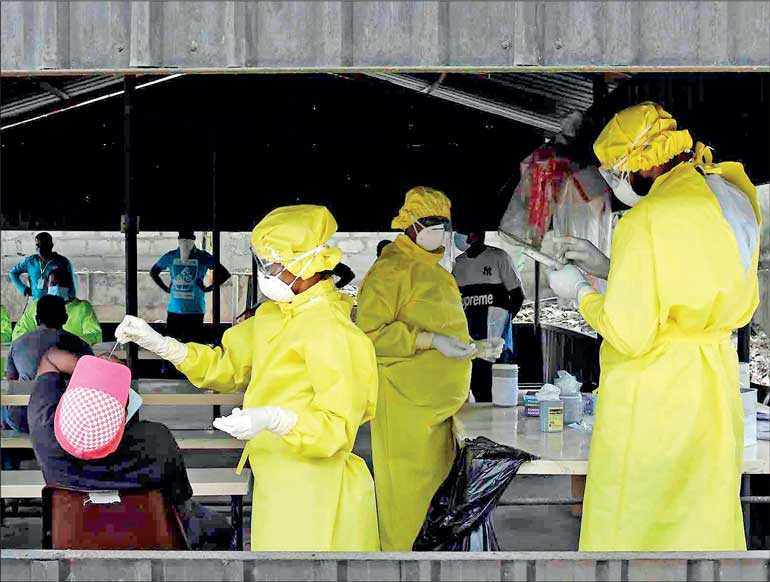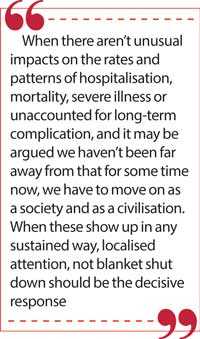Monday Apr 07, 2025
Monday Apr 07, 2025
Wednesday, 7 October 2020 00:03 - - {{hitsCtrl.values.hits}}

What makes some tests ‘better’ for diagnostic purposes is, as this is a test that amplifies molecules, how many cycles of amplification are required to ‘detect’ the virus – Pic by Shehan Gunasekara
A few weeks back in Sri Lanka, a Russian pilot was purportedly ‘COVID positive’. This was down south. I was told while in Kandy, that the nature reserve in which we were hiking would shut down early, at 1  p.m., to ‘protect against COVID’.
p.m., to ‘protect against COVID’.
Leave aside the plausibility of the actual motivation, I could not fathom, what relevance an infection of some days back, in the south of the island, would have, in terms of ‘danger’ in the outdoors, in a nature reserve in Kandy. Yet people still make these statements with a straight face – suggesting our fear mongering has outstripped our prudence. (Several tests later, it turns out he was ‘negative’ for COVID after all).
As I write, a 39-year-old worker in an apparel factory in Gampaha being tested positive for COVID-19 has rightly led to wide-scale contact tracing, and localised lockdown (which hopefully will be short-lived, and evidence based). But headlines are everywhere making it ‘news’ that after two months an instance of local transmission has been uncovered.
And this leads me to realise that we have to make our ‘peace’ with some facts, and our leaders have to convey this to us, or we simply will stay paralysed, and no tourism industry (among other things) will ever be possible again.
Tests
The founder of the PCR tests, winner of the Nobel Prize in Chemistry, clearly indicates these tests are not meant for diagnostic purposes! Leaflets that come with all these tests say the same thing. The website of the CDC in the US ‘confesses’ the same, saying that ‘detection’ of viral residue is not proof of a live, active infection.
There are lawsuits being mounted globally as I write arguing that we have failed to distinguish between the COVID epidemic and the PCR Test epidemic, which may not be one and the same thing at all, but the latter is being used to verify the former.
What makes some tests ‘better’ for diagnostic purposes is, as this is a test that amplifies molecules, how many cycles of amplification are required to ‘detect’ the virus.
As Dr. Mina, epidemiologist at the Harvard School of Public Health states, “It is the amount of virus that should dictate the infected patient’s next steps. It’s really irresponsible to forgo the recognition that this is a quantitative issue.”
As he explains, the PCR test ‘amplifies’ genetic material ‘in cycles’. The fewer cycles required, the greater the amount of the virus (viral load). The higher the viral load, the greater the likelihood for contagiousness. Currently, doctors are not given the ‘cycle threshold’, which is the number of amplification cycles needed to ‘detect’ the virus. Yet that is needed to know how infectious patients are for all practical purposes!
So, where are our Sri Lankan tests set? I have urged in a prior article that we seek to harmonise with global best practice here if we haven’t already lest we pointlessly create panic, or limit our strategies re welcoming back tourists, or indeed carefully and prudently having Sri Lanka truly fully ‘open for business’.
Which cell?
There are four COVID ‘cells’ we can opt to occupy.
Cell A: High cases and high casualty counts. Think Brazil. Cell B: Low cases and low casualties. Think New Zealand, but without really enough immunity building up, every time you open the borders, spikes take place, back to lockdown, and round and round we go.
Cell C: Low cases and high casualties, let’s skip this option, though we’ve seen numerous countries or regions in countries flirt with this, absent any measures.
Cell D: High cases (so viral transmission burns through and effective immunity develops) and low mortality (Japan, even Sweden post nursing homes, pockets of the US).
So far, Lanka has been in Cell B, and that’s great. But post-curfew, there has been an election and a great deal of local travel and interaction, and I think we can be confident there isn’t currently widespread local much less community transmission. However, we may have to understand a ‘case’ is not the primary issue, as it could be a false positive, or just the asymptomatic presence of a virus that will grow milder and be contained. To open up, we may have to safely and carefully be ‘open’ to experiencing Cell D, lest we cower forever. For if we do that, what happens when the next pathogen comes along? It’s not a sustainable strategy.
The ‘Casedemic’
Not surprisingly we are finding COVID deaths plummeting worldwide as cases rise (which on the above we might cheer). But by calling a ‘positive test’ a ‘case’ we have mangled medicine beyond recognition. A ‘case’ is someone with symptoms. Researchers from the future reviewing this pandemic will have little idea therefore who died ‘from’ it and who died, coincidentally ‘with’ it.
Lockdown happened because we were told COVID could kill 1%. There was a gross computational error, advertent or inadvertent which conflated the IFR (infection fatality rate) with the CFR (case fatality rate among those already ill with symptoms). We were told at least 1% might die from COVID, when actually it’s .1%.
Stating that but for lockdown it would have been higher is simply not borne out globally, as cases and deaths were already past their peak and declining in virtually every country that introduced lockdown.
Foolishly we keep trying to protect the young, the children, who are at almost zero risk. And then we sent sick elders into nursing homes so they could practice being superspreaders among the most vulnerable. And of course, we know the ripple effects, heart attacks and strokes not treated, cancer treatments stopped, abused women and children trapped at home, economies crippled, companies and entire industries wiped out.
The UK estimates “We stripped out the NHS and left millions in prolonged pain and suffering, on ever lengthening waiting lists, which have doubled. There have been tens of thousands of delayed cancer diagnoses – the effects of which are yet to be seen.” But the medical journal ‘Lancet’ estimates that at least ‘sixty thousand years of life will have been lost’.
So ‘lockdown’ was a complete and utter disaster as practiced, precipitated by the claim COVID was going to kill 1%. Sweden, a living lab, didn’t lock down, even with nursing home mortality being close to 75% of deaths there, has had a death rate of 0.0058%.
So what is success?
Over the last decade of seeking ‘vaccines’ only three times have we even achieved a 50% success rate we are told by researchers at Universities like Oxford and Stanford. And above the age of 75, vaccines are highly problematic.
Against that, relative to defining success, some ‘death’ perspective. 8,000 people die daily in the US roughly (roughly 12,000 per month in Sri Lanka). Average life expectancy in the US is 78.6 years, and COVID fatalities surge above 80, a group at high risk of death, no matter from what unfortunately. Three million people per annum in the US die of ‘miscellaneous causes’ mostly occurring in old age, 650,000 from heart attacks by way of comparison.
So, as Yale Researcher Dr. David Katz points out, “no deaths from or with COVID” is like asking for utopia.
Zero circulating virus can’t do the trick either, as pathogens circulate all the time, from gonorrhoea to adenovirus, salmonella, herpes, Lyme disease to Hepatitis C-. And go hunting for these in ‘asymptomatic’ people and you’ll find the wherewithal for them as well, with far more reliable testing! So COVID will likely just migrate to being a part of our epidemiology.
Of all the diseases encountered, we are reminded by leading researchers, once our species has been established as a suitable host, none have ever been fully eliminated, vaccine or not…with only one exception, smallpox.
When there aren’t unusual impacts on the rates and patterns of hospitalisation, mortality, severe illness or unaccounted for long-term complication, and it may be argued we haven’t been far away from that for some time now, we have to move on as a society and as a civilisation. When these show up in any sustained way, localised attention, not blanket shut down should be the decisive response.
As we now know this coronavirus was likely circulating as early as October 2019, the number of those exposed and infected is likely many times what we know. Hence to call it a ‘second wave’ is silly, we are into the ‘fourth wave’, though we may have delayed or deferred our experience by extended, intemperate shutdowns.
Also, our ‘tests’ flail and fail us for reasons explained earlier (they were not meant for diagnosis, and without setting the tests for the right viral load, sheer ‘recognition’ of viral debris may well be irrelevant). Just taking the difference between the deaths per million in Sweden and the US, either implies COVID-19 likes Swedes better and hates Americans as Dr. Katz ruefully dismisses, or that many more in the US have been exposed than we know. This is likely true globally, including say in China and India potentially. That being the case, we may be verging on herd immunity far more so than the ‘official’ numbers indicate.
And that also renders the ‘infection fatality rate’ to be even less than feared, depending on geography, medium pandemic influenza to a normal flu/influenza season. Sweden’s national fatality rate (total COVID ascribed deaths divided by the population) is roughly .06%. Apply that same rate to the US and you get 198,000, which seems in the neighbourhood of published data, compounded by burdens of lockdown, general health, etc.
Be a little more cautious and take the globally benchmarked IFR (Infection Fatality Rate) of 0.03% and reverse engineer the US numbers taking the 200 k as valid and it would show not 6.5 million infected in the US but 67 million.
And as the gap between case counts and casualty counts continues to widen, and most of the cases now are young healthy people, we must resist the unscientific ‘panic’ of closures, lockdowns, and quarantines without any discernment or distinction.
There are claims of ‘reinfection’, but these are both extremely rare and so far, seem to be milder variants, nothing to overwhelm immune systems or the medical system as best we know today.
There is also no credible evidence of cardiac crises flowing from this pathogen. With such a high pool of those ‘infected’ that would have by now been very hard to conceal.
More on children
As of 11 May, we were advised “Children have virtually no risk from COVID-19 nor are they a vector of transmission.” While some children have indeed perished, those who died were already seriously ill. England’s Deputy Chief Medical Officer Dr. Jenny Harries says children are at more risk from flu or car accidents. And statistically speaking, have greater chance of being struck by lightning.
In France, researchers found a symptomatic child with COVID-19 in a well-publicised study did not spread infection to any of 112 school contacts. In an Australian report (which must have confounded the ruling junta there) explicitly on school transmission (NSW study prepared by the National Centre for Immunisation Research and Surveillance) looked at the spread of infection across 15 schools from 18 original infections in nine students and nine staffers. Secondary spread among students was rare, less than 1%, and no cases of spread from student to staff.
In China, a review of 31 household outbreaks found only three were initiated by a child. While this is a small sample, corroborating studies have emerged from schools in Taiwan, South Korea and Sweden, all places without universal school closures or any sustained widespread lockdown, and with far better COVID and economic stats than so many who lurched down the path of mass house arrest, compelled economic suicide and compromising the future of children. (As a codicil, as abused kids can’t go to school, there has been a spike in child abuse, teachers can’t see the evidence to report it; all this is ignored under the fog of pandemic mania).
The Washington Post capitulates to facts
On 25 September, they reported despite 200,000 or so alleged deaths ‘with’ or ‘from’ COVID in the US (we truly don’t know which), only 100 children and teenagers have died, and comorbidities are not ruled out, on the contrary. The same article indicates, “18 states have not seen a single fatality among people under 20 as of September 10th, based on the American Academy of Pediatrics.” As also corroborated in the UK, children in these countries are more likely to die, by far of homicides, drowning, fires and car crashes.
As another comparison point, California, in seven months of school reopening, nine million kids, 84,000 cases…two deaths (with other contributing illnesses as well).
We need to define COVID success
It is incumbent upon policy makers here, hopefully heartened and even better informed by the preceding, to help us determine a “COVID bull’s eye” so we can be at the forefront of not only successful COVID management but economic rebound, by which we can safeguard lives, livelihoods, the present and the future, with as much discernment as we can marshal alongside the discipline and dedication so impressively showcased by our admirable front line responders in the field.